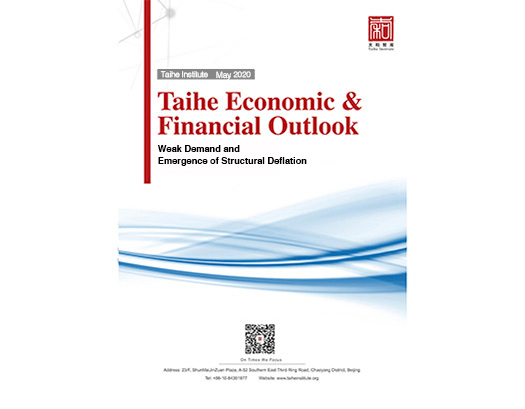Weak Demand and Emergence of Structural Deflation
Set out below is an analysis of China’s economic and financial data for April 2020 in the Taihe Economic & Financial Outlook (May 2020 issue):
1. The main reason why the CPI returned to the “3 Era” in April 2020 was that food prices tended to stabilize and began to decline. A further decline in PPI growth was due to weak demand and lower commodity prices. Price fluctuations reflected the imbalance of supply and demand, but the root cause was the disturbance of money supply.
2. The decline in China’s manufacturing PMI in April 2020 was mainly due to the continued weakness of demand, especially foreign demand, but the rate of recovery in production had already approached its peak. It will take time for domestic demand to recover, and foreign demand will be further weakened due to the COVID-19 epidemic and the economic recession. Insufficient demand is a key factor inhibiting future PMI recovery.
3. The growth rate of fixed-asset investment from January to April 2020 continued to rebound after bottoming out in the first quarter. However, the revival of infrastructure investment and real estate investment are the main driving forces for the improved data. Although infrastructure investment can support the economy to some extent, the law of diminishing marginal returns is becoming increasingly significant in the context of overall weak demand. Excessive infrastructure investment will certainly lead to, among others, a rise in leverage ratios and a lack of efficiency, thus restricting subsequent development.
4. In terms of consumption, the magnitude of the decline in consumption data in all areas has narrowed in April 2020, which mainly reflected the short-term effect of the implementation of various consumption stimulus policies. The epidemic’s restrictions on social activities and the trade-in commodities are far from being eliminated. Consumption data tends to be affected by short-term volatility, but the long-term trend in consumption has been hampered by excessive borrowing and shrinking income growth in the household sector.
5. In terms of foreign trade, global demand cannot be restored in the short term given the difficulties in containing the epidemic around the world. China’s exports and imports in the first four months of 2020 have been negatively affected to some extent. Although the RMB export data in April 2020 rebounded by more than expected, non-economic factors were considered the main reasons behind this. This is still consistent with Taihe Economic & Financial Outlook’s prediction of increasing difficulties for China’s exports in the future.
6. In terms of industrial value-added, the increase of industrial value-added in April 2020 was in line with Taihe Economic & Financial Outlook’s prediction, and returned to an upward trajectory. Although the recovery of the growth rate in industrial value-added reflected that the supply side is gradually emerging from its predicament, continuing weakness in demand will eventually be transmitted to the supply side of the industrial sector.
7. In April 2020, total social financing continued to exceed market expectations, and the main increase came from corporate bonds and RMB loans. M2 growth continues to rise sharply, showing that in the context of the severe macroeconomic impact of the outbreak, both central bank’s monetary policy hedging and money supply have increased significantly.
Taihe Economic and Financial Outlook takes a look at global financial market trends from April to mid-May 2020 :
1. Bond market: in May 2020 domestic bonds continued the momentum of a rebound in yields since the end of April. It is expected that fiscal policy will be further strengthened, and the interest rate bonds will come under pressure due to its massive issuance. Overall, the market was dominated by bearish factors with no drivers to push down interest rates for the time being.
2. Stock market: the European and the U.S. stock markets fluctuated upward throughout the period. The unprecedented rescue efforts by the Federal Reserve relieved the liquidity issues for U.S. stocks promptly. After the market panic was effectively eased, U. S. stocks quickly picked up. Asian stock markets have performed well as a result of the U.S. stock rally. However, now that the U.S. stock rebound has been in place, the market will face greater downward pressure in the future. For the A-share market, the logic of long-term trend has not changed, but we also anticipate downward pressure on A-shares in the short term.
3. Commodities: in terms of gold, global stock markets generally performed well due to declining risk aversion sentiment in global capital markets. This, combined with investors’ expectations of restarting economies, has led to a mild fluctuation instead of a sharp fall in gold prices, despite some pressure at the higher end. As the major factors supporting the price of gold have not fundamentally changed, the price of gold can still obtain strong support, and the gold trend is expected to remain at a high level. In terms of crude oil, prices show a “V” shape trajectory, projecting a downward trend at first, followed by a sharp upward fluctuation. The underlying reason for the recent oil price recovery was that the deal to cut oil output helped to achieve a new balance in oil prices and that the resumption of work in various countries has partly repaired investors’ pessimistic expectations. In terms of supply, all countries have promised to reduce production to a certain extent, and the oversupply has been alleviated. However, insufficient demand is the main reason for the current oil price downturn. In the short term, the production of oil producers cannot completely offset the contraction of demand, and crude oil lacks the basis for a price surge.
—————————————————————
ON TIMES WE FOCUS.
Should you have any questions, please contact us at public@taiheglobal.org
